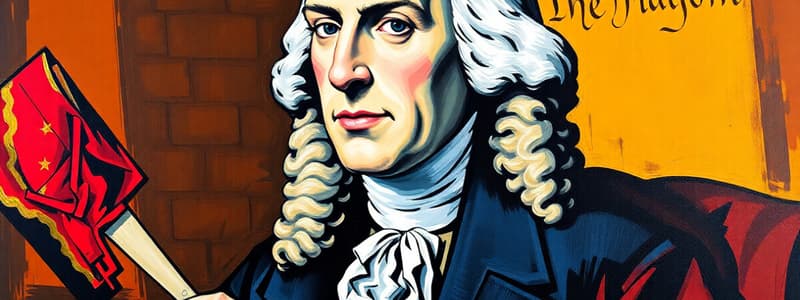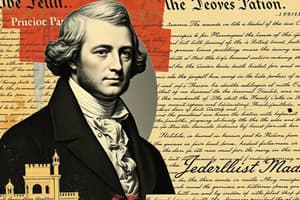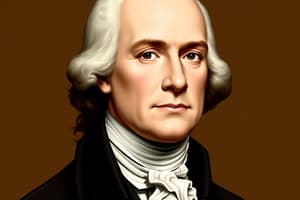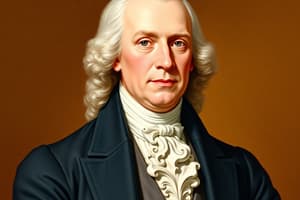Podcast
Questions and Answers
What role is James Madison often credited with in relation to the Constitution?
What role is James Madison often credited with in relation to the Constitution?
James Madison is often called the 'Father of the Constitution'.
What was the primary challenge Madison faced regarding the Articles of Confederation?
What was the primary challenge Madison faced regarding the Articles of Confederation?
Madison believed that a stronger national government was needed to address the weaknesses of the Articles of Confederation.
Despite Madison's efforts, what concern did many delegates have about a strong central government?
Despite Madison's efforts, what concern did many delegates have about a strong central government?
Many delegates distrusted the power of a strong central government.
In which room did Madison prepare for the Constitutional Convention?
In which room did Madison prepare for the Constitutional Convention?
What external conditions did Madison and the delegates face during the summer of 1787 in Philadelphia?
What external conditions did Madison and the delegates face during the summer of 1787 in Philadelphia?
How did Madison's appearance and demeanor contrast with his influential role?
How did Madison's appearance and demeanor contrast with his influential role?
What preparations did Madison make to participate effectively in the convention?
What preparations did Madison make to participate effectively in the convention?
At what age was Madison influential during the Convention of 1787?
At what age was Madison influential during the Convention of 1787?
What was the Virginia Plan and who primarily authored it?
What was the Virginia Plan and who primarily authored it?
What significant role did James Madison play at the Constitutional Convention?
What significant role did James Madison play at the Constitutional Convention?
What was the main dispute among delegates regarding the national legislature?
What was the main dispute among delegates regarding the national legislature?
Who were some of the prominent delegates present at the Virginia delegation?
Who were some of the prominent delegates present at the Virginia delegation?
What was the Great Compromise and why was it significant?
What was the Great Compromise and why was it significant?
Why was travel challenging for delegates attending the convention?
Why was travel challenging for delegates attending the convention?
What compromise was reached regarding the executive branch?
What compromise was reached regarding the executive branch?
What method did Madison use to keep track of convention proceedings?
What method did Madison use to keep track of convention proceedings?
What concerns did Madison have after the Constitution was completed?
What concerns did Madison have after the Constitution was completed?
What was the temperature condition like during the Convention proceedings?
What was the temperature condition like during the Convention proceedings?
When was the Constitution officially signed by most delegates?
When was the Constitution officially signed by most delegates?
What was the purpose of the Committee on Style?
What was the purpose of the Committee on Style?
How many words were in the final document of the Constitution?
How many words were in the final document of the Constitution?
What were the delegates’ accommodations during the convention?
What were the delegates’ accommodations during the convention?
Flashcards
The Constitution
The Constitution
The document that established the framework for the US government, outlining its structure, powers, and responsibilities.
Constitutional Convention
Constitutional Convention
A series of meetings held in Philadelphia in 1787 where delegates from the thirteen states convened to revise the Articles of Confederation but ended up creating a new system of government.
Articles of Confederation
Articles of Confederation
The first governing document of the United States, adopted in 1781, which created a weak central government with limited powers.
James Madison
James Madison
Signup and view all the flashcards
Constitutional Convention Process
Constitutional Convention Process
Signup and view all the flashcards
Distrust of a Strong Central Government
Distrust of a Strong Central Government
Signup and view all the flashcards
Madison's Advocacy for a Strong National Government
Madison's Advocacy for a Strong National Government
Signup and view all the flashcards
Madison's Vision vs. Final Outcome
Madison's Vision vs. Final Outcome
Signup and view all the flashcards
Virginia Plan
Virginia Plan
Signup and view all the flashcards
Great Compromise
Great Compromise
Signup and view all the flashcards
Connecticut Compromise
Connecticut Compromise
Signup and view all the flashcards
Separation of Powers
Separation of Powers
Signup and view all the flashcards
Checks and Balances
Checks and Balances
Signup and view all the flashcards
Popular Sovereignty
Popular Sovereignty
Signup and view all the flashcards
Committee on Style
Committee on Style
Signup and view all the flashcards
Ratification
Ratification
Signup and view all the flashcards
Federalism
Federalism
Signup and view all the flashcards
Nationalism
Nationalism
Signup and view all the flashcards
Legislature
Legislature
Signup and view all the flashcards
Executive Branch
Executive Branch
Signup and view all the flashcards
Judicial Branch
Judicial Branch
Signup and view all the flashcards
Study Notes
James Madison and the Constitutional Convention of 1787
- Madison, considered the "Father of the Constitution," played a pivotal role in its creation.
- The process involved over 100 days of negotiation and compromise.
- He sought a stronger national government to replace the Articles of Confederation.
- Madison faced opposition from those who feared a powerful central authority.
The Challenging Summer of 1787 in Philadelphia
- The summer was exceptionally hot and humid, with swarms of black flies.
- The climate made indoor work difficult.
- The convention took place in the Pennsylvania State House, East Room.
- Madison secured a front-row seat, to effectively observe, record, and note proceedings.
Madison's Preparation and Leadership
- A young man (36), small of stature (5'6"), Madison was known for his hard work and keen intellect.
- Madison prepared thoroughly for the convention, having spent years in Congress, studying political theory.
- His work on the Virginia Constitution (1776) influenced his role as a political thinker.
- Madison's quiet demeanor and sharp intellect fostered agreement among fellow delegates.
The Convention's Participants
- Delegates were primarily wealthy, educated white men, mainly lawyers or landowners (excluding workers, tradesmen, women, African Americans, and American Indians).
- The Indian Queen Inn was a social hub for convention delegates.
- Key early figures involved in discussions were George Washington, George Mason, and Edmund Randolph.
- The Virginia Plan, a set of 15 proposals, articulated Madison's vision for a new government.
The Convention's Start and Structure
- The scheduled start of the convention (May 14th) was delayed due to travel difficulties, leading to May 25th as its official commencement.
- The delegates committed to secrecy, but the stifling heat intensified negotiations.
- Detailed notes were taken by Madison for the convention's record, a painstaking process that "almost killed" him.
The Virginia Plan and Debate
- Randolph's proposal for a new government based on a "supreme Legislative, Executive, & Judiciary" was swiftly approved.
- Disagreement arose over representation in the national legislature (Congress): balancing the interests of both the people and the states.
- The executive branch structure faced debate: single executive versus a triumvirate, length of term, selection method.
The Great Compromise and Conclusion
- The Great Compromise of July 16th addressed concerns about representation in Congress.
- Madison conceded some points, but the convention proceeded toward completion.
- A committee was formed to create the final draft (primarily Madison, with 4 other members)
- The final Constitution comprised 4,300 words.
- The constitution was unanimously approved to be sent to the various states, September 17, 1787.
Madison's Impact and Reflection
- Although not entirely aligning with Madison's prefered vision of governance (he believed it conferred too much power to the states), he played a crucial role in its creation.
- He focused on achieving a working consensus, and acceptance of the outcome.
- Madison’s focus on the document's future ratification and implementation of the new government took precedence.
Studying That Suits You
Use AI to generate personalized quizzes and flashcards to suit your learning preferences.




